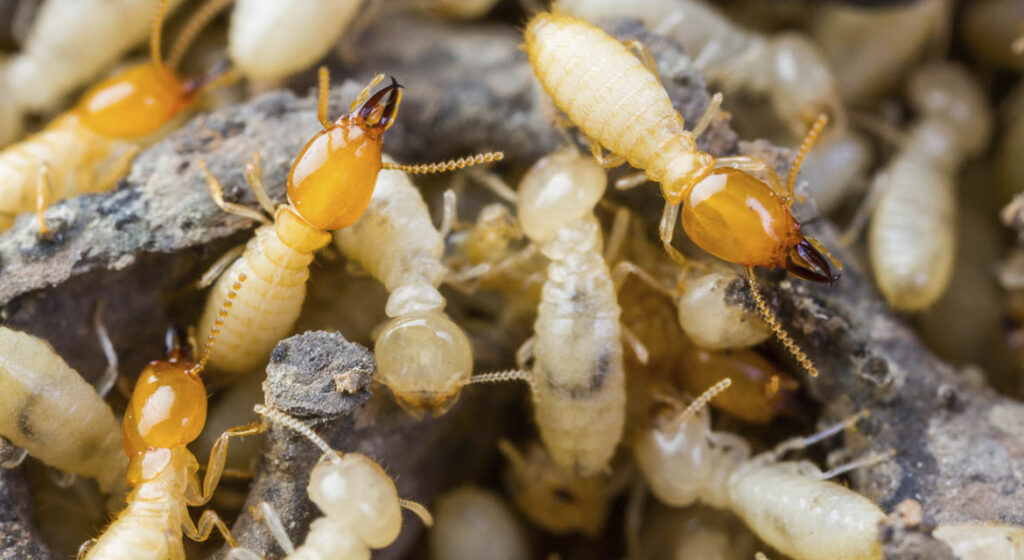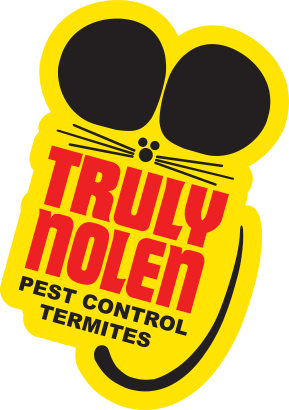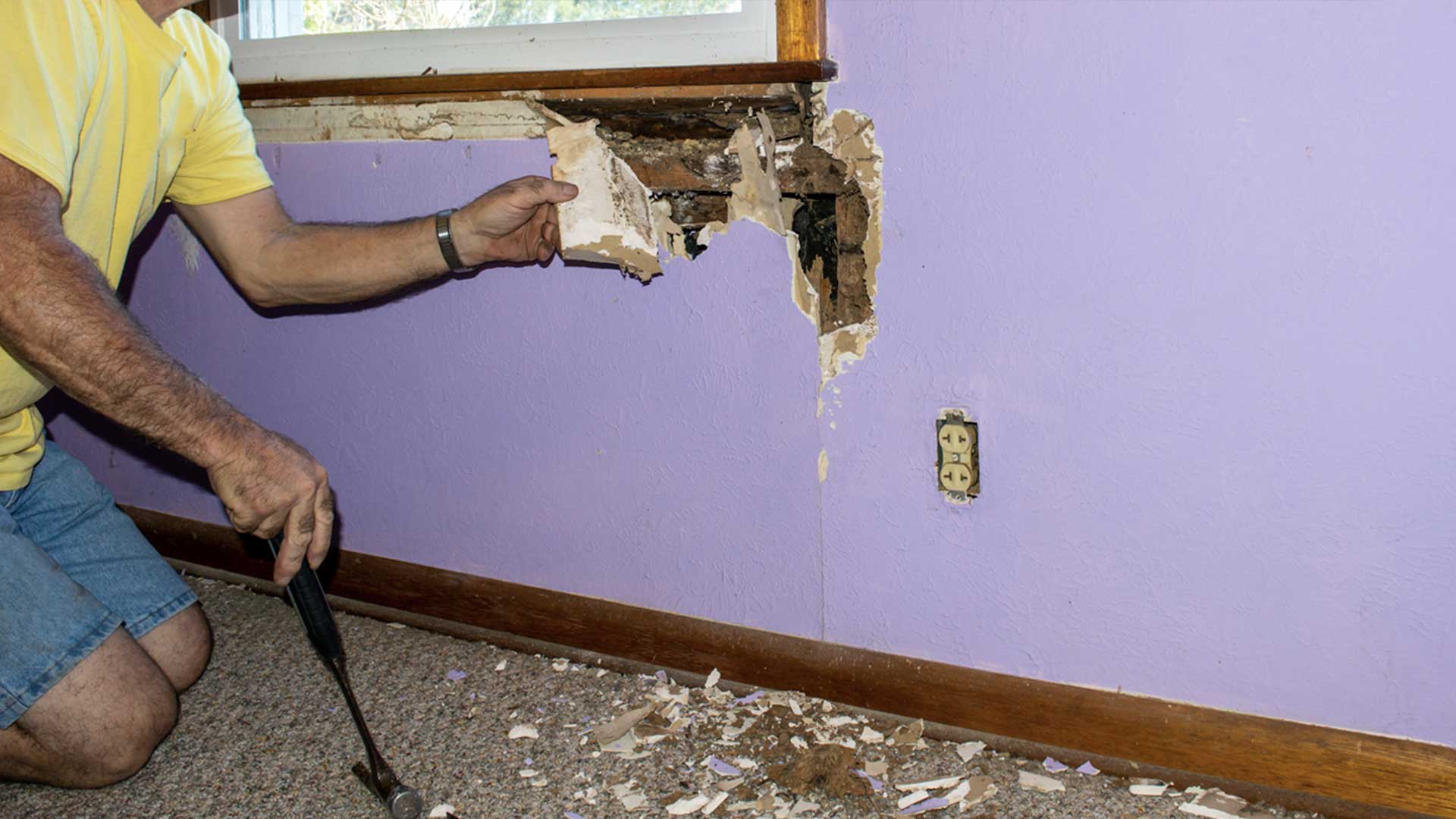
How to Identify a Termite Infestation
To identify a termite infestation, inspect for physical evidence like mud tubes, discarded wings, and wood damage. Additionally, observe swarmers and workers, and if in doubt, seek professional inspection from a licensed pest control expert to accurately assess the situation and determine the appropriate course of action. Here are three key things to look for:
- Look for physical evidence of a termite infestation, such as mud tubes, discarded wings, and wood damage.
- Observe swarmers and workers, including flying termites during mating season and pale, soft-bodied worker termites in search of food.
- Seek professional inspection from a licensed pest control expert to accurately assess termite presence and damage, guiding appropriate treatment options.
Identifying Termites Overview
Are you worried about termites in your home? That is a legitimate fear. Termites are small insects that feed on wood, paper, and other cellulose materials. When termites invade your home or property, they can cause severe structural damage by eating away at the foundation and structure of your building. To keep the problem manageable and inexpensive, you must identify an infestation before it becomes a major problem.
If you suspect you have termites in your home, don’t panic! There are several steps that you can take to treat an infestation effectively. This article will teach you how to identify and solve a termite infestation.
Knowing the Warning Signs of a Termite Infestation
Termites are small, destructive pests that can cause significant damage to homes and structures if left unchecked. Recognizing the warning signs of a termite infestation early on can help you take prompt action and minimize potential damage.
Here are some common signs to look out for:
- Discarded wings: Termites shed their wings once they find a suitable place to build their colony. So if you notice piles of tiny, translucent wings around your home or yard, that could indicate an active termite infestation nearby.
- Mud tubes: Another sign of an active termite infestation is mud tubes. You will often find these small tunnels made from mud and dirt on walls, floors, or ceilings. The mud tubes provide termites with moisture and security as they travel between their nest and food source.
- Termite droppings: Termites produce tiny pellets known as frass or fecal matter. Because termites exclusively eat wood, the frass will look like piles of sawdust.
- Hollow-sounding wood: Watch for hollow-sounding wood or damaged structures around your home. Termites eat away at wood from the inside out, leaving only a thin layer on the surface. You likely have termites if you tap on wooden structures around your house and hear a hollow sound or notice visible damage.
- Buckling or blisters in wood flooring: Buckling or blisters in wood flooring could indicate termite damage. Termites burrow through the wood, creating tunnels that weaken structural integrity.

Truly Nolen GUARANTEE
If you’re not completely satisfied, you’ll get a full refund on your most recent service with our 100% money back guarantee.

$50 Off Year Round Pest Control
Truly Nolen is a family-owned company with 85 years of experience providing the best pest control. If you’re not completely satisfied, you’ll get a full refund on your most recent service with our 100% money back guarantee.
Confirming the Presence and Extent of Termites with Inspection
If you suspect you have termites in your home or property, the best way to confirm their presence and determine the extent of the infestation is to get a professional inspection. A trained termite inspector will carefully examine your property for signs of termite activity and damage.
During the inspection process, the inspector will look for the following things.
- Live termites: The inspector will begin their inspection by looking for live termites. They will spend time examining areas where they are likely to be found, such as near moist soil areas, wooden structures (e.g., furniture), or walls.
- Swarmers: If you see flying termites, called swarmers, around your home, that is a sign of an active termite colony nearby. A termite inspector will be able to identify the type of termites and recommend appropriate control measures.
- Termite wings: The inspector will also look for discarded termite wings near windows, doors, or other entry points. Their presence could indicate a recent termite swarm in your area.
- Presence of worker termites: If you see worker termites crawling around your property, there is likely an established colony nearby. An experienced termite inspector can distinguish worker termites from swarmers and other termite colony members.
Preventing Further Damage with Termite Control
Once you have confirmed the presence of termites in your home or property, you must take steps to prevent further damage.
Some common methods for controlling termites include the following.
- Chemical treatments: Chemical treatments involve applying pesticides or other chemicals to the soil around your home or directly onto wooden structures. These treatments can be effective at killing termites and preventing future infestations.
- Bait stations: Bait stations are small containers filled with wood and slow-acting poison attractive to termites. Once a termite finds the bait station, it will carry the poison back to its colony, slowly killing off the entire colony over time.
- Physical barriers: Physical barriers like metal mesh screens or sand can help prevent termites from accessing wooden structures on your property.
Spotting a Termite Infestation: Hard-to-Open Windows or Tight-Fitting Doors
As you have probably realized by now, spotting a termite infestation as soon as possible is essential for effective extermination and damage control. Therefore, knowing the signs to look for is critical.
We have already mentioned some of the most common signs of a termite infestation above. However, a few less well-known signs could indicate a termite problem. The first we will discuss is hard-to-open windows and tight-fitting doors.
Stuck Windows and Tight-Fitting Doors are Common Signs of a Termite Infestation.
Termites feed on wood, which means they can cause significant structural damage to your home over time. When they tunnel through window frames or door sills, they weaken the wood’s structure, causing it to warp or bend. As a result, you may find it challenging to open or close your windows and doors smoothly.
Do not ignore the issue if your windows or doors have become increasingly difficult to open or close. Instead, consider calling in a professional pest control service for an inspection.
Termites can Cause Damage to Window Sills, Frames, and even Walls and Ceilings.
While warped window frames and door sills are telltale signs of a termite infestation, these are not the only wooden places that termites affect. The pests can also tunnel through walls and ceilings. They especially love wooden beams or joists.
Over time, termite damage can lead to severe structural damage that requires costly repairs. Cracks in your walls, ceilings, or soft spots on your home’s floors could indicate termite activity. Noticing any of these things means you should contact a pest control professional immediately.
Attics and Crawl Spaces are also Common Places for Termites to Tunnel Through.
Attics and crawl spaces are other areas where termites thrive. They provide easy access points for termites, allowing the pests to easily move around your home and find new food sources, such as insulation or wooden support beams.
Look for Exit Holes or Small Holes in the Wood Around Windows and Doors.
If you suspect termite activity in your home, look for signs of damage, such as small holes in the wood. The tiny holes are exit points where termites have chewed their way through the wood. Window frames and door sills will most often have these small holes.
If You Suspect Termite Damage, Seek Professional Help to Assess the Extent of the Problem.
If you are experiencing any of the issues mentioned above or suspect a termite infestation, do not wait to seek help. Termites can cause extensive and costly damage if left untreated.
A professional pest control service can assess the extent of the problem and provide treatment options tailored to your specific needs. They can also offer advice on preventing future infestations by making changes around your home, such as reducing moisture levels and removing decaying wood sources.
Spotting a Termite Infestation: Damage Under Paint or Wallpaper
Termites are silent destroyers capable of causing extensive damage to homes and structures. Spotting termite damage under paint or wallpaper can be challenging because these coverings can mask the visible signs of infestation. Yet, there are subtle signs that you can check for. We have listed the most important of these below.
Bubbling Under Wallpaper or Flaking Paint on Walls can Indicate Termite Damage Underneath.
One of the most common signs of a termite infestation is bubbling or flaking paint. Termites eat wood and cellulose materials and create tunnels and galleries in the wood, which can weaken it over time. This weakening of the wood can lead to it warping, cracking, and ultimately causing your wall paint to bubble and peel off. The warping may also cause bubbling under your wallpaper.
If you notice any bubbling or flaking paint on your walls, it’s important to investigate further. You may need to remove some of the damaged areas to see if there is any underlying damage that needs repair.
Termites can also Leave Pencil-Thin Mud Tubes on Walls, Indicating their Presence.
Bubbling wallpaper and peeling paint can indicate termite damage inside your walls. However, there may be external signs of a termite infestation as well. This sign is pencil-thin mud tubes on your walls.
Termites create these tubes as they travel from their nests to their food sources. They use mud tubes to protect themselves from predators and maintain a humid environment while traveling through dry areas.
You must immediately contact a professional exterminator if you notice any mud tubes in or around your home. They can develop a treatment plan to eliminate the infestation from your home.
Spotting a Termite Infestation: Mud Tubes
Identifying termite mud tubes is an important step in recognizing the presence of termites and assessing the extent of an infestation. Here is the most important information you need to know to identify termite mud tubes.
What is a Termite Mud Tube?
Termite mud tubes are one of the most common signs of termite infestation. They are small tunnels made of soil, wood particles, and termite saliva that termites use as a means of transportation between their nests and food sources. These tubes provide shelter for termites, ensure they have the correct moisture levels, and protect them from predators.
How to Identify Mud Tubes?
You can find mud tunnels on walls, foundations, and other surfaces. They look like thin lines or mud tubes. Termites make them from brown dirt, which may appear wet or dry depending on the environment. The diameter of these tunnels can range from 1/4 inch to 1 inch wide, depending on the colony’s size and the type of termite.
Termites will create mud tubes anywhere they live and feed, including the following places.
- Crawl spaces
- Basements
- Attics
- Outdoor wooden structures, such as decks and fences
Carefully examine these areas for any signs of mud tubes. Use a flashlight to check dark corners or areas where termites might be hiding. Pay close attention to areas where wood meets soil since this is a common spot for termite activity.
Spotting a Termite Infestation: Head Banging or Chewing Noises
You likely have an active infestation if you have identified termite mud tubes or some of the other signs discussed in this article. However, not all types of termites build mud tubes, so you should also look for other signs, such as head banging or chewing noises.
Termites Make Distinctive Noises when They are Disturbed
Termites are known for being silent destroyers, but a large colony will make noises that can indicate their presence. One of the termites’ most distinctive sounds is a head-banging or chewing noise. They will make these noises most distinctly when they are disturbed.
How to Identify Termite Noises
Tap on wood structures around your home if you suspect a termite infestation. If you hear a hollow sound, this could indicate termite damage. If you listen closely, you may also hear termites banging their heads or chewing through the wood. These noises are most audible when there are large numbers of termites present.
What Can You Do if You Hear Termite Noises?
If you hear any termite noises in your home, you must take action immediately. Hearing audible head banging or chewing indicates an extremely large termite colony. The longer you wait to get help, the more damage the termites can cause.
Spotting a Termite Infestation: Discarded Wings and Swarmers
Discovering termites can be a homeowner’s worst nightmare. These silent destroyers can wreak havoc on the structural integrity of your home, causing costly damage if left untreated. Identifying a termite infestation early is crucial for effective pest control.
One telltale sign of a termite infestation is the presence of discarded wings and swarmers. By identifying these signs, homeowners will better understand when to take action, potentially saving their homes from extensive termite damage and costly repairs.
What are Termite Swarmers?
Termite swarmers, also known as alates, are reproductive termites that leave established colonies to start new ones. Mature termite colonies usually produce alates when environmental conditions are favorable, such as during warm and humid weather. They emerge from the colony in large groups, known as swarms, usually in spring.
The purpose of termite swarmers is to mate and establish new termite colonies. They have wings that enable them to fly for short distances. Once they find a suitable mate, the male and female pair up and shed their wings, they then burrow into the soil to establish a new termite colony.
Termite swarmers are a natural part of the termite life cycle and serve an important role in the expansion and survival of termite colonies. However, their presence near or inside a building can indicate a termite infestation, as it suggests an established termite colony nearby.
What do Termite Swarmers Look Like?
Alates of different termite species can vary in appearance. Generally, they have a dark-colored body with straight antennae and four wings of equal size. The wings of termite swarmers are often longer than their body length. They are easily mistaken for flying ants, but there are distinct differences, such as the straight antennae and uniform wing size of termite swarmers.
Why do Termites Shed Their Wings?
After finding a mate, termite swarmers shed their wings because they no longer need them as they begin building a new nest or colony.
How can Discarded Wings Indicate the Presence of Termites?
You may find discarded wings on windowsills, door frames, or other areas that attract the alates during their flight. The presence of these wings means there was a recent swarm of termites in your area, indicating an established colony nearby.
What Should I Do if I Find Discarded Wings?
Call a pest control professional immediately if you find discarded wings around your home or property. A professional can determine if there is an active infestation and provide treatment options if necessary.

$50 Off Year Round Pest Control
Truly Nolen is a family-owned company with 85 years of experience providing the best pest control. If you’re not completely satisfied, you’ll get a full refund on your most recent service with our 100% money back guarantee.
Termite Damage on the Outside of Your Home: What to Do
Damage outside your home can cause concern, as it may indicate the presence of termites and potential structural issues. Taking prompt action is crucial to prevent further damage.
Below we have listed a few steps to determine if you have termites outside your home.
Check for Mud Tubes on the Outside of Your Home
Termites build mud tubes both inside and outside a house. The outer mud tubes will occur along the foundation or exterior walls. Termites use these tubes to travel from their underground colonies to their food source, often the wooden structures in your home. Therefore, checking for mud tubes is essential if you suspect termite activity around your home.
Look for small tunnels or tubes made of mud running up and down these surfaces. If you find these tubes, break them open and check inside for live termites or termite eggs.
Inspect Wooden Structures Outside Your Home for Signs of Damage Caused by Termites
Termites feed on wood and other cellulose-based materials. As such, they can cause significant damage to wooden structures outside your home if left unchecked.
Look for signs such as the following.
- Sagging or buckling wooden decks or patios
- Peeling paint or wallpaper on exterior walls
- Weakened wooden structures on fences or sheds
- Visible holes in wooden beams or posts
- Sawdust-like material in piles on the ground around wooden structures
Contact a Professional Exterminator Immediately if You Suspect Termite Damage on the Exterior of Your Home
Contacting a professional exterminator is essential if you suspect termite activity outside your home. Termites living outside your home can easily find their way inside. Once inside, they can cause significant damage to your home’s structure and foundation, leading to costly repairs.
A professional exterminator can help you identify the extent of the infestation and provide treatment options to eliminate it. They may use various methods to eradicate termites from your property, including liquid treatments or bait stations.
In addition to treating the current infestation, an exterminator can provide preventative measures to protect your home from future termite damage. These treatments may include regular inspections or installing physical barriers, such as mesh screens or metal flashing around wooden structures.
Importance of Year-Round Termite Prevention
Termites are among the most destructive pests, causing extensive damage to homes and property. Many homeowners do not realize they have a termite problem until it’s too late. At that point, the damage has already been done. All that’s left are costly extermination services and repairs.
That is why year-round termite prevention is so crucial. Protecting your home from termites will keep your property in good condition for years to come.
The Role of Pest Control Professionals
One of the best ways to prevent termites from infesting your home is by working with pest control professionals. These experts have the knowledge and experience necessary to identify signs of termite activity before it becomes a major problem.
During regular inspections, pest control professionals look for signs of termites, such as mud tubes, damaged wood, or discarded wings. If they detect any signs of an infestation, they will eradicate the termites using safe and effective methods.
Pest control professionals can also help you implement preventative measures, such as bait stations and barrier treatments. These measures create a protective barrier around your home that deters termites from entering or nesting inside.
Regular Inspections Catch Termites Early
Regular inspections are critical for catching termite activity before it causes significant damage to your property. Most experts recommend having at least one annual inspection during spring or summer when termite activity is highest.
During an inspection, the pest control professional will thoroughly examine your property’s interior and exterior for signs of termite activity. If they detect any signs of an infestation or potential entry points, they will address the issue before it becomes a more significant problem.
Preventative Measures Save You Money
Investing in preventative measures, such as bait stations and barrier treatments, can save you money. Bait stations work by luring termites away from your home into a trap that exterminates them. Barrier treatments create a protective barrier around your property that termites cannot penetrate. While these measures may require an initial investment, they are much less expensive than repairing structural damage caused by termites.
Be Proactive and Protect Your Home Year-Round
Don’t wait for signs of termites to bring in the professionals. Instead, work with pest control professionals to schedule regular inspections and implement preventative measures. By being proactive and protecting your home year-round, you can avoid costly repairs and keep your property in good condition.
When to Call a Truly Nolen Professional for Termite Infestation
Termites are one of the most destructive pests. They can damage wooden structures and cause thousands of dollars in repair costs if left untreated. Therefore, early detection is crucial. Professional pest control experts, such as those at Truly Nolen, can help you keep termites out of your home for good.
Why is Professional Termite Inspection Necessary?
The first step in dealing with termites is identifying whether you have an infestation. Even if you suspect termites, it’s not always easy to determine the extent of the problem. That’s why a professional termite inspection is necessary.
Truly Nolen professionals are trained to identify termite infestations. They use advanced tools and techniques, such as moisture meters, thermal imaging cameras, and acoustic emission devices, to locate termites hiding inside walls, ceilings, and floors.
During the inspection process, they will also look for signs of termite activity, such as mud tubes, damaged wood, and discarded wings. Based on their findings, they will provide you with a detailed report outlining the extent of the infestation and recommend an appropriate treatment plan.
How can Truly Nolen Professionals Help You?
If you have termites in your home, there are several ways a Truly Nolen professional can help, including the following.
- Identify the type of termite: There are multiple termite species, each with its own unique characteristics and behavior patterns. A Truly Nolen professional will help you identify the type of termite that has invaded your home.
- Recommend treatment options: A Truly Nolen professional will recommend various treatment options, such as liquid treatments or baiting systems, depending on the severity of the infestation and your budget and preferences.
- Provide long-term protection: Once they have successfully eradicated the termites from your home, Truly Nolen professionals will provide long-term protection against future infestations. They may recommend regular inspections, treatments, or other preventative measures to keep your home termite-free.
Final Thoughts
Acting quickly is important if you suspect your home has a termite infestation. Termites can cause significant damage to your property if left untreated.
If you suspect that you have a termite problem despite taking preventive measures, it’s best to call a professional pest control service like Truly Nolen. They will inspect your property thoroughly and provide effective treatment and prevention options.
Early detection is the key to solving termite problems. Don’t wait until it’s too late to take action!

$50 Off Year Round Pest Control
Truly Nolen is a family-owned company with 85 years of experience providing the best pest control. If you’re not completely satisfied, you’ll get a full refund on your most recent service with our 100% money back guarantee.
Frequently Asked Questions
Can I treat termites on my own?
While some DIY products exist, effective termite control often requires professional expertise and specialized equipment for thorough elimination and long-term protection. Learn More!
Are termites harmful to humans?
While termites don’t pose direct health threats, their presence can cause significant structural damage and financial implications. Learn More!
How do I know if I have termites?
Look for signs like mud tubes, discarded wings, damaged wood with hollowed-out sections, and droppings resembling wood pellets. Learn more about termites
How much does termite treatment cost?
The cost varies based on factors like the extent of the infestation, property size, and chosen treatment method. It’s best to request a professional inspection and obtain a customized quote. Learn More!
How can I prevent termite infestations?
Prevention includes reducing moisture, maintaining proper ventilation, removing wood-to-soil contact, and conducting regular inspections. Learn More!

